Public Health and Social Care: Roles, Strategies, and Impact Report
VerifiedAdded on 2020/12/10
|8
|2496
|458
Report
AI Summary
This report, focusing on Unit 11, delves into the critical role of public health and social care. It begins by outlining the responsibilities of various agencies in determining health levels, examining both infectious and non-infectious diseases through epidemiological lenses. The report evaluates the effectiveness of different strategies employed to control diseases, including screening, immunization, and educational campaigns. It then explores current priorities and approaches of services for people with diseases, particularly focusing on sexually transmitted diseases (STDs). Furthermore, the report analyzes the relationship between disease prevalence and service requirements, along with the impact of current lifestyle choices on future healthcare needs. The conclusion underscores the importance of public health agencies in identifying and addressing health issues, emphasizing the need for effective strategies to promote individual and community well-being. The report also mentions the importance of lifestyle choices on health, including exercise, healthy diet, and reducing alcohol intake.
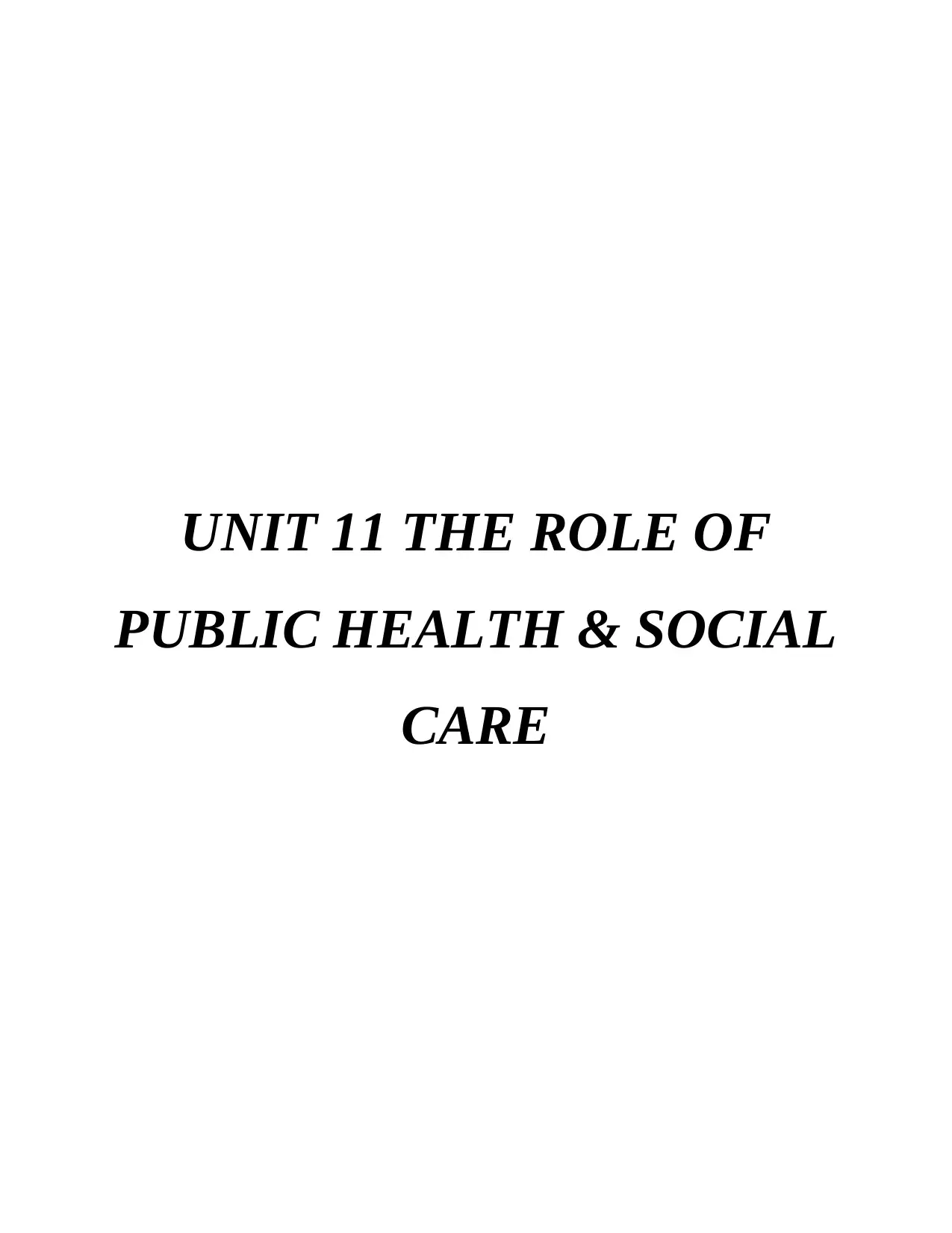
UNIT 11 THE ROLE OF
PUBLIC HEALTH & SOCIAL
CARE
PUBLIC HEALTH & SOCIAL
CARE
Paraphrase This Document
Need a fresh take? Get an instant paraphrase of this document with our AI Paraphraser
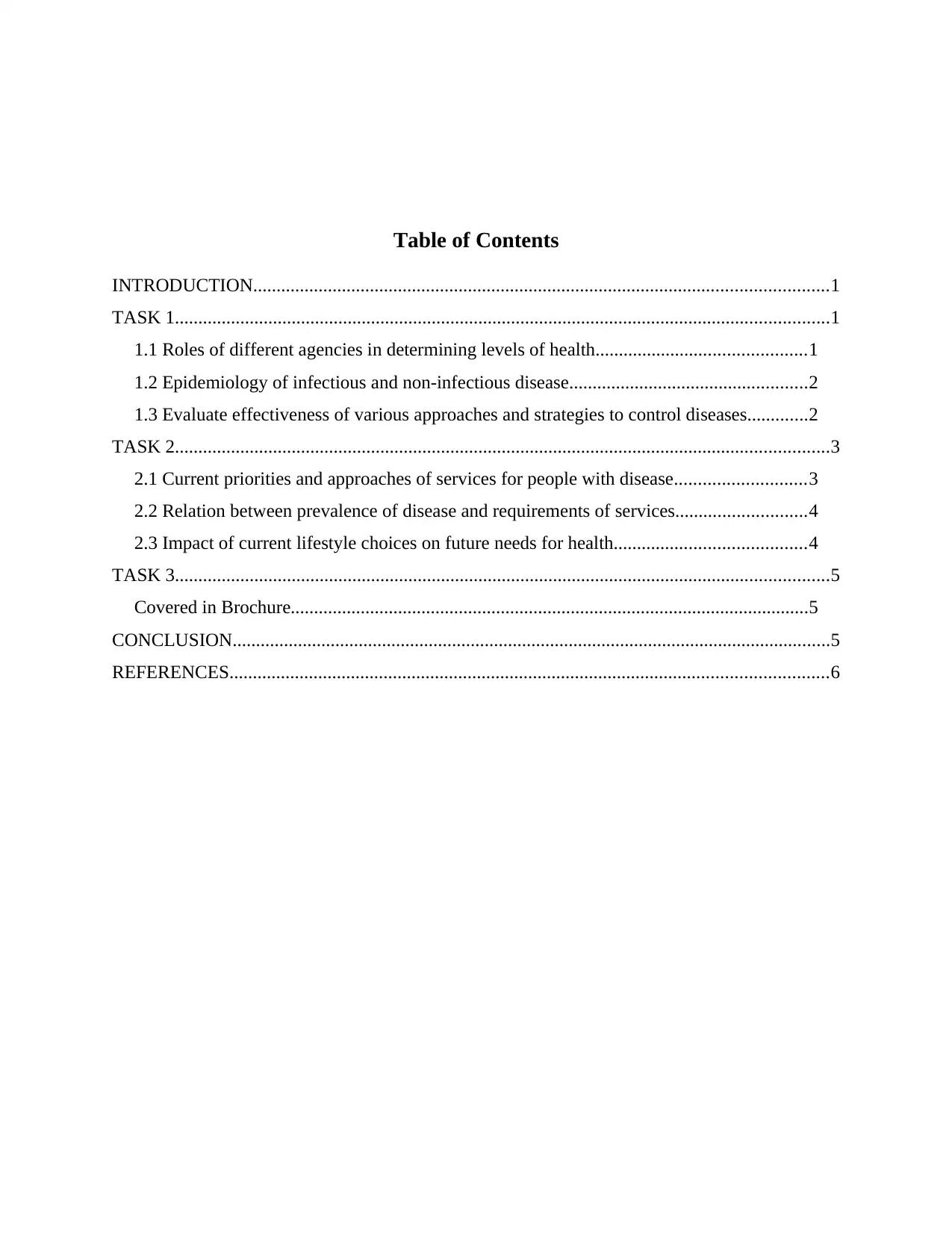
Table of Contents
INTRODUCTION...........................................................................................................................1
TASK 1............................................................................................................................................1
1.1 Roles of different agencies in determining levels of health.............................................1
1.2 Epidemiology of infectious and non-infectious disease...................................................2
1.3 Evaluate effectiveness of various approaches and strategies to control diseases.............2
TASK 2............................................................................................................................................3
2.1 Current priorities and approaches of services for people with disease............................3
2.2 Relation between prevalence of disease and requirements of services............................4
2.3 Impact of current lifestyle choices on future needs for health.........................................4
TASK 3............................................................................................................................................5
Covered in Brochure...............................................................................................................5
CONCLUSION................................................................................................................................5
REFERENCES................................................................................................................................6
INTRODUCTION...........................................................................................................................1
TASK 1............................................................................................................................................1
1.1 Roles of different agencies in determining levels of health.............................................1
1.2 Epidemiology of infectious and non-infectious disease...................................................2
1.3 Evaluate effectiveness of various approaches and strategies to control diseases.............2
TASK 2............................................................................................................................................3
2.1 Current priorities and approaches of services for people with disease............................3
2.2 Relation between prevalence of disease and requirements of services............................4
2.3 Impact of current lifestyle choices on future needs for health.........................................4
TASK 3............................................................................................................................................5
Covered in Brochure...............................................................................................................5
CONCLUSION................................................................................................................................5
REFERENCES................................................................................................................................6
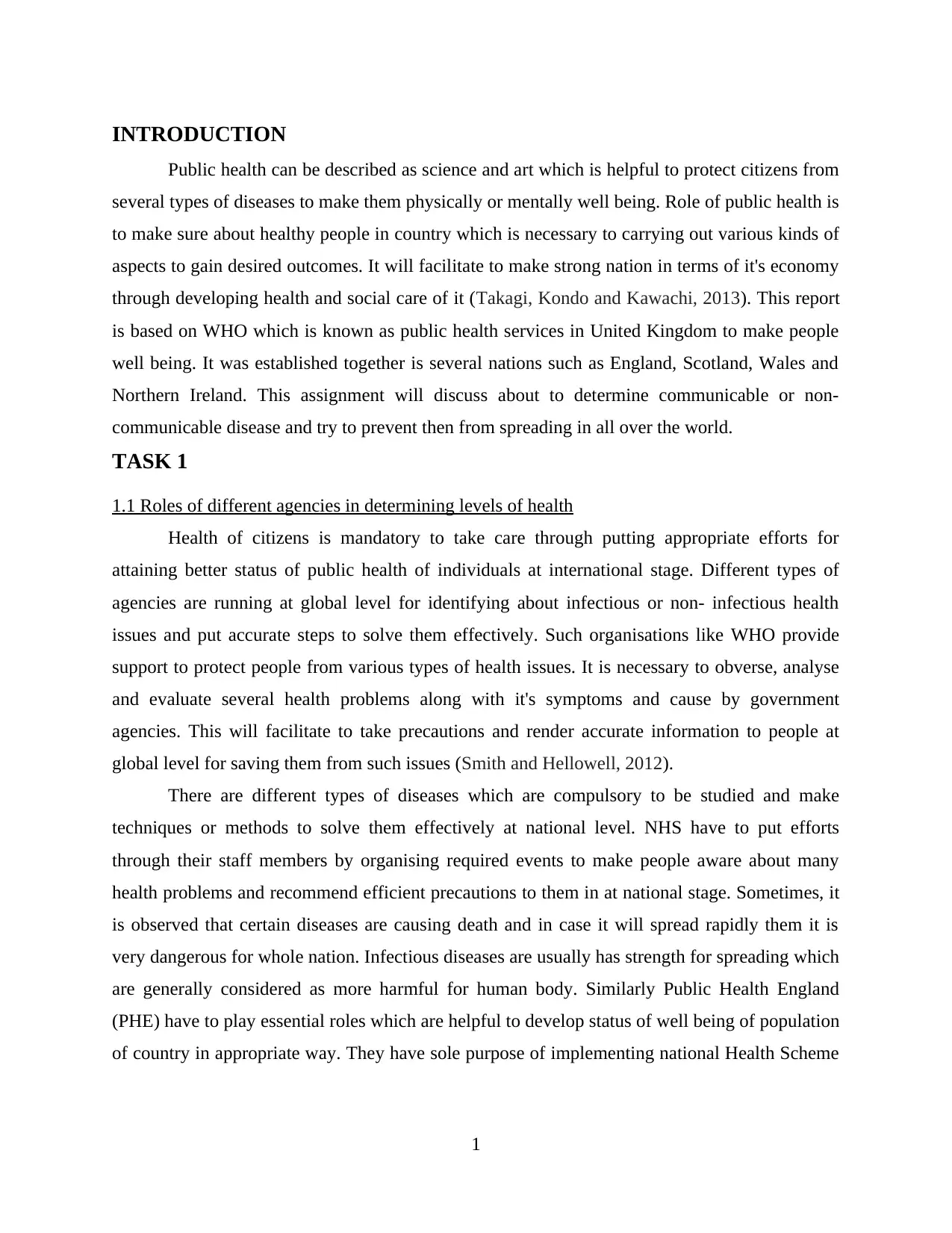
INTRODUCTION
Public health can be described as science and art which is helpful to protect citizens from
several types of diseases to make them physically or mentally well being. Role of public health is
to make sure about healthy people in country which is necessary to carrying out various kinds of
aspects to gain desired outcomes. It will facilitate to make strong nation in terms of it's economy
through developing health and social care of it (Takagi, Kondo and Kawachi, 2013). This report
is based on WHO which is known as public health services in United Kingdom to make people
well being. It was established together is several nations such as England, Scotland, Wales and
Northern Ireland. This assignment will discuss about to determine communicable or non-
communicable disease and try to prevent then from spreading in all over the world.
TASK 1
1.1 Roles of different agencies in determining levels of health
Health of citizens is mandatory to take care through putting appropriate efforts for
attaining better status of public health of individuals at international stage. Different types of
agencies are running at global level for identifying about infectious or non- infectious health
issues and put accurate steps to solve them effectively. Such organisations like WHO provide
support to protect people from various types of health issues. It is necessary to obverse, analyse
and evaluate several health problems along with it's symptoms and cause by government
agencies. This will facilitate to take precautions and render accurate information to people at
global level for saving them from such issues (Smith and Hellowell, 2012).
There are different types of diseases which are compulsory to be studied and make
techniques or methods to solve them effectively at national level. NHS have to put efforts
through their staff members by organising required events to make people aware about many
health problems and recommend efficient precautions to them in at national stage. Sometimes, it
is observed that certain diseases are causing death and in case it will spread rapidly them it is
very dangerous for whole nation. Infectious diseases are usually has strength for spreading which
are generally considered as more harmful for human body. Similarly Public Health England
(PHE) have to play essential roles which are helpful to develop status of well being of population
of country in appropriate way. They have sole purpose of implementing national Health Scheme
1
Public health can be described as science and art which is helpful to protect citizens from
several types of diseases to make them physically or mentally well being. Role of public health is
to make sure about healthy people in country which is necessary to carrying out various kinds of
aspects to gain desired outcomes. It will facilitate to make strong nation in terms of it's economy
through developing health and social care of it (Takagi, Kondo and Kawachi, 2013). This report
is based on WHO which is known as public health services in United Kingdom to make people
well being. It was established together is several nations such as England, Scotland, Wales and
Northern Ireland. This assignment will discuss about to determine communicable or non-
communicable disease and try to prevent then from spreading in all over the world.
TASK 1
1.1 Roles of different agencies in determining levels of health
Health of citizens is mandatory to take care through putting appropriate efforts for
attaining better status of public health of individuals at international stage. Different types of
agencies are running at global level for identifying about infectious or non- infectious health
issues and put accurate steps to solve them effectively. Such organisations like WHO provide
support to protect people from various types of health issues. It is necessary to obverse, analyse
and evaluate several health problems along with it's symptoms and cause by government
agencies. This will facilitate to take precautions and render accurate information to people at
global level for saving them from such issues (Smith and Hellowell, 2012).
There are different types of diseases which are compulsory to be studied and make
techniques or methods to solve them effectively at national level. NHS have to put efforts
through their staff members by organising required events to make people aware about many
health problems and recommend efficient precautions to them in at national stage. Sometimes, it
is observed that certain diseases are causing death and in case it will spread rapidly them it is
very dangerous for whole nation. Infectious diseases are usually has strength for spreading which
are generally considered as more harmful for human body. Similarly Public Health England
(PHE) have to play essential roles which are helpful to develop status of well being of population
of country in appropriate way. They have sole purpose of implementing national Health Scheme
1
⊘ This is a preview!⊘
Do you want full access?
Subscribe today to unlock all pages.

Trusted by 1+ million students worldwide
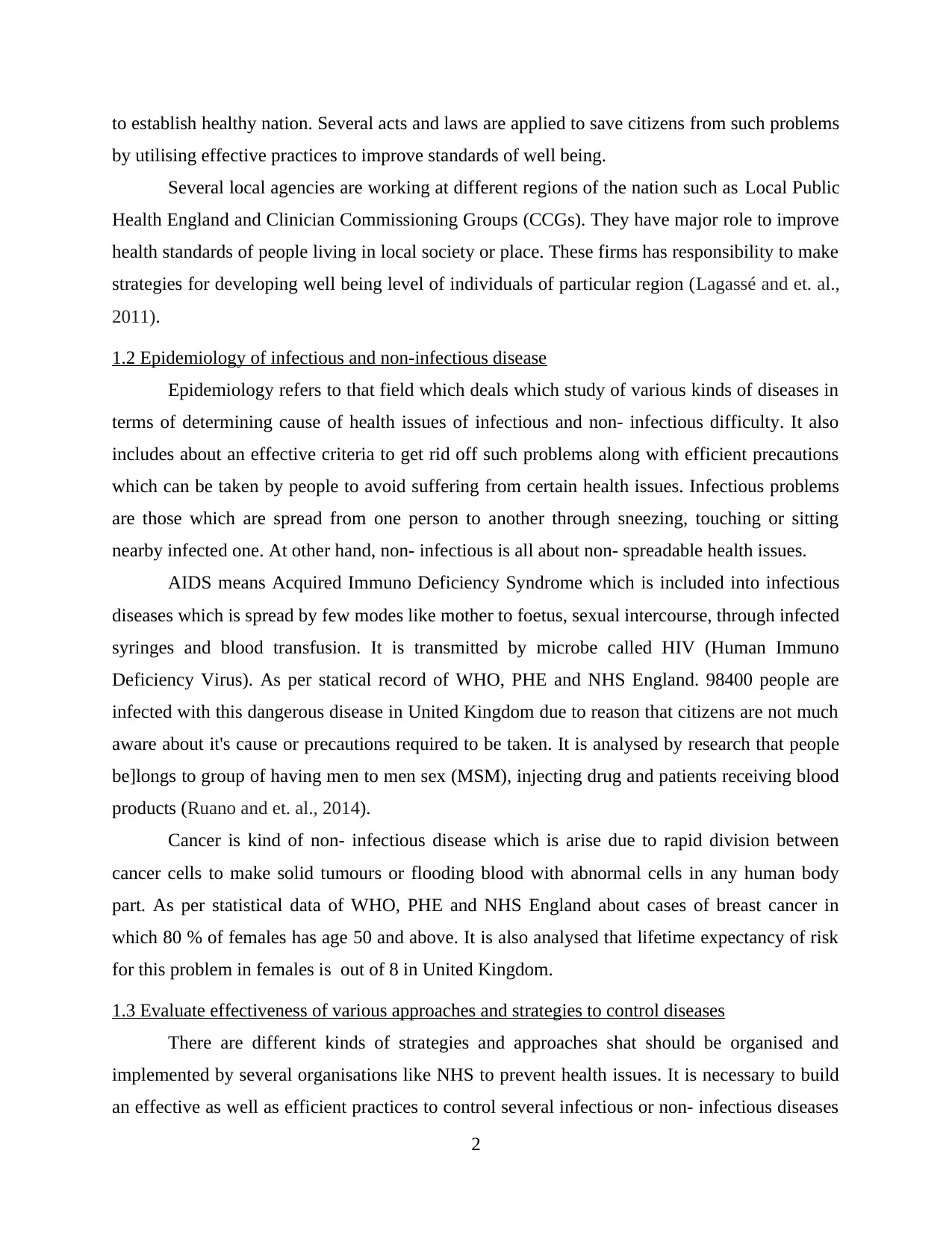
to establish healthy nation. Several acts and laws are applied to save citizens from such problems
by utilising effective practices to improve standards of well being.
Several local agencies are working at different regions of the nation such as Local Public
Health England and Clinician Commissioning Groups (CCGs). They have major role to improve
health standards of people living in local society or place. These firms has responsibility to make
strategies for developing well being level of individuals of particular region (Lagassé and et. al.,
2011).
1.2 Epidemiology of infectious and non-infectious disease
Epidemiology refers to that field which deals which study of various kinds of diseases in
terms of determining cause of health issues of infectious and non- infectious difficulty. It also
includes about an effective criteria to get rid off such problems along with efficient precautions
which can be taken by people to avoid suffering from certain health issues. Infectious problems
are those which are spread from one person to another through sneezing, touching or sitting
nearby infected one. At other hand, non- infectious is all about non- spreadable health issues.
AIDS means Acquired Immuno Deficiency Syndrome which is included into infectious
diseases which is spread by few modes like mother to foetus, sexual intercourse, through infected
syringes and blood transfusion. It is transmitted by microbe called HIV (Human Immuno
Deficiency Virus). As per statical record of WHO, PHE and NHS England. 98400 people are
infected with this dangerous disease in United Kingdom due to reason that citizens are not much
aware about it's cause or precautions required to be taken. It is analysed by research that people
be]longs to group of having men to men sex (MSM), injecting drug and patients receiving blood
products (Ruano and et. al., 2014).
Cancer is kind of non- infectious disease which is arise due to rapid division between
cancer cells to make solid tumours or flooding blood with abnormal cells in any human body
part. As per statistical data of WHO, PHE and NHS England about cases of breast cancer in
which 80 % of females has age 50 and above. It is also analysed that lifetime expectancy of risk
for this problem in females is out of 8 in United Kingdom.
1.3 Evaluate effectiveness of various approaches and strategies to control diseases
There are different kinds of strategies and approaches shat should be organised and
implemented by several organisations like NHS to prevent health issues. It is necessary to build
an effective as well as efficient practices to control several infectious or non- infectious diseases
2
by utilising effective practices to improve standards of well being.
Several local agencies are working at different regions of the nation such as Local Public
Health England and Clinician Commissioning Groups (CCGs). They have major role to improve
health standards of people living in local society or place. These firms has responsibility to make
strategies for developing well being level of individuals of particular region (Lagassé and et. al.,
2011).
1.2 Epidemiology of infectious and non-infectious disease
Epidemiology refers to that field which deals which study of various kinds of diseases in
terms of determining cause of health issues of infectious and non- infectious difficulty. It also
includes about an effective criteria to get rid off such problems along with efficient precautions
which can be taken by people to avoid suffering from certain health issues. Infectious problems
are those which are spread from one person to another through sneezing, touching or sitting
nearby infected one. At other hand, non- infectious is all about non- spreadable health issues.
AIDS means Acquired Immuno Deficiency Syndrome which is included into infectious
diseases which is spread by few modes like mother to foetus, sexual intercourse, through infected
syringes and blood transfusion. It is transmitted by microbe called HIV (Human Immuno
Deficiency Virus). As per statical record of WHO, PHE and NHS England. 98400 people are
infected with this dangerous disease in United Kingdom due to reason that citizens are not much
aware about it's cause or precautions required to be taken. It is analysed by research that people
be]longs to group of having men to men sex (MSM), injecting drug and patients receiving blood
products (Ruano and et. al., 2014).
Cancer is kind of non- infectious disease which is arise due to rapid division between
cancer cells to make solid tumours or flooding blood with abnormal cells in any human body
part. As per statistical data of WHO, PHE and NHS England about cases of breast cancer in
which 80 % of females has age 50 and above. It is also analysed that lifetime expectancy of risk
for this problem in females is out of 8 in United Kingdom.
1.3 Evaluate effectiveness of various approaches and strategies to control diseases
There are different kinds of strategies and approaches shat should be organised and
implemented by several organisations like NHS to prevent health issues. It is necessary to build
an effective as well as efficient practices to control several infectious or non- infectious diseases
2
Paraphrase This Document
Need a fresh take? Get an instant paraphrase of this document with our AI Paraphraser

in appropriate manner for making a healthy society. Some of approaches such as screening,
immunisation, education, legislation, social welfare and environmental controls play an essential
role to improve health level of citizens.
Certain educational events or campaigns should be organised to make people aware about
health issues and render suggestions to take effective precautions to protect people. Various
types of legislations should be implemented which helps to reduce negative impacts of health of
human body. Immunisation is all about to increase to efficiency of immune system of individuals
which provide support to gain development of public health (Borgelt, Buchman and Illes, 2012).
It also includes certain methods to make clean surroundings which render help to avoid health
problems. Screening is one of most effective strategy through which people are required to have
regular check ups which are supportive to determine diseases at initial stage and easy to
diagnose.
TASK 2
2.1 Current priorities and approaches of services for people with disease
There are various kinds of diseases which are mandatory to be analysed in terms of it's
causes, priorities and diagnosing criteria. It is necessary to identify several reasons behind health
issues and methods to prevent it from spreading it amongst citizens. In case of sexually
transmitted disease (STDs), it can be solve or prevent by certain techniques. Some of them which
can be applied by NHS are as follows:
Primary prevention :- This refers to organise effective events or campaigns through
which education about several dangerous and infectious diseases. An accurate knowledge about
STDs like AIDS, syphilis etc. should be provided to citizens along with rendering information
about techniques to prevent them by taking efficient precautions by NHS.
Secondary prevention :- It refers to organise several programs of providing free of cost
treatment or check ups of pregnant ladies (Steffenak and et. al., 2015). In case of STDs, NHS can
establish camps for rendering an appropriate technique such as blood tamest to identify disease
and medication to stop transferring that health problem from mother to foetus.
Tertiary prevention :- This can be described as method of providing an effective
treatment to patient who is suffering from specific health problem. In case of STDs like AIDS
3
immunisation, education, legislation, social welfare and environmental controls play an essential
role to improve health level of citizens.
Certain educational events or campaigns should be organised to make people aware about
health issues and render suggestions to take effective precautions to protect people. Various
types of legislations should be implemented which helps to reduce negative impacts of health of
human body. Immunisation is all about to increase to efficiency of immune system of individuals
which provide support to gain development of public health (Borgelt, Buchman and Illes, 2012).
It also includes certain methods to make clean surroundings which render help to avoid health
problems. Screening is one of most effective strategy through which people are required to have
regular check ups which are supportive to determine diseases at initial stage and easy to
diagnose.
TASK 2
2.1 Current priorities and approaches of services for people with disease
There are various kinds of diseases which are mandatory to be analysed in terms of it's
causes, priorities and diagnosing criteria. It is necessary to identify several reasons behind health
issues and methods to prevent it from spreading it amongst citizens. In case of sexually
transmitted disease (STDs), it can be solve or prevent by certain techniques. Some of them which
can be applied by NHS are as follows:
Primary prevention :- This refers to organise effective events or campaigns through
which education about several dangerous and infectious diseases. An accurate knowledge about
STDs like AIDS, syphilis etc. should be provided to citizens along with rendering information
about techniques to prevent them by taking efficient precautions by NHS.
Secondary prevention :- It refers to organise several programs of providing free of cost
treatment or check ups of pregnant ladies (Steffenak and et. al., 2015). In case of STDs, NHS can
establish camps for rendering an appropriate technique such as blood tamest to identify disease
and medication to stop transferring that health problem from mother to foetus.
Tertiary prevention :- This can be described as method of providing an effective
treatment to patient who is suffering from specific health problem. In case of STDs like AIDS
3

which can only get prevent or reduce it's impact but there is no treatment is invented by scientists
to cure about this disease.
The above mentioned factors are compulsory to prevent and cure any health issues
effectively as well a efficiently to get required outcomes through applying an appropriate
techniques (Douglas and et. al., 2011).
2.2 Relation between prevalence of disease and requirements of services
Prevalence refers to ratio or proportion of affected by any particular disease which has
negative impact on citizens. It includes comparison of infected persons in total number of
individuals present in population. At the other hand, it is mandatory to put effective efforts to
solve health issues within a community. A technique which involve accurate allocation of
resources in correct way to gain desired results including provision of priority well being
services which is known as health governance.
Sometimes, it is observed and analysed that sudden outbreak of infectious disease like
Swine Influenza takes place. In this condition, it is compulsory to take several actions to prevent
spreading of the disease and solving it effectively. It includes various activities such as campaign
to create awareness, generating an emergency helpline and make sure about those people who
were isolated and given a Tamiflu vaccination properly.
Several steps should be taken by NHS like smoking cessation initiatives, a nationwide
smoking ban in public places and a prohibition of selling cigarettes to adolescents and young
people. All these actions are helpful to prevent certain dangerous diseases from country. Apart
from these aspects, harm principle refers to certain steps which are taken by individuals to
prevent harm of other persons (Choi and et. al., 2015).
2.3 Impact of current lifestyle choices on future needs for health
Life style of an individual plays an important role to prevent several diseases and avoid
them to suffer from them. Current habits on regular basis should be choose by a person which
save people from future health problems. Some of these activit9ise which can be recommend by
NHS to citizens is given below:
Increased exercise :- This refers to criteria of adopting physical exercise or oga ion
regular basis which provide support to improve immunity and facilitate to reduce health issues
properly.
4
to cure about this disease.
The above mentioned factors are compulsory to prevent and cure any health issues
effectively as well a efficiently to get required outcomes through applying an appropriate
techniques (Douglas and et. al., 2011).
2.2 Relation between prevalence of disease and requirements of services
Prevalence refers to ratio or proportion of affected by any particular disease which has
negative impact on citizens. It includes comparison of infected persons in total number of
individuals present in population. At the other hand, it is mandatory to put effective efforts to
solve health issues within a community. A technique which involve accurate allocation of
resources in correct way to gain desired results including provision of priority well being
services which is known as health governance.
Sometimes, it is observed and analysed that sudden outbreak of infectious disease like
Swine Influenza takes place. In this condition, it is compulsory to take several actions to prevent
spreading of the disease and solving it effectively. It includes various activities such as campaign
to create awareness, generating an emergency helpline and make sure about those people who
were isolated and given a Tamiflu vaccination properly.
Several steps should be taken by NHS like smoking cessation initiatives, a nationwide
smoking ban in public places and a prohibition of selling cigarettes to adolescents and young
people. All these actions are helpful to prevent certain dangerous diseases from country. Apart
from these aspects, harm principle refers to certain steps which are taken by individuals to
prevent harm of other persons (Choi and et. al., 2015).
2.3 Impact of current lifestyle choices on future needs for health
Life style of an individual plays an important role to prevent several diseases and avoid
them to suffer from them. Current habits on regular basis should be choose by a person which
save people from future health problems. Some of these activit9ise which can be recommend by
NHS to citizens is given below:
Increased exercise :- This refers to criteria of adopting physical exercise or oga ion
regular basis which provide support to improve immunity and facilitate to reduce health issues
properly.
4
⊘ This is a preview!⊘
Do you want full access?
Subscribe today to unlock all pages.

Trusted by 1+ million students worldwide
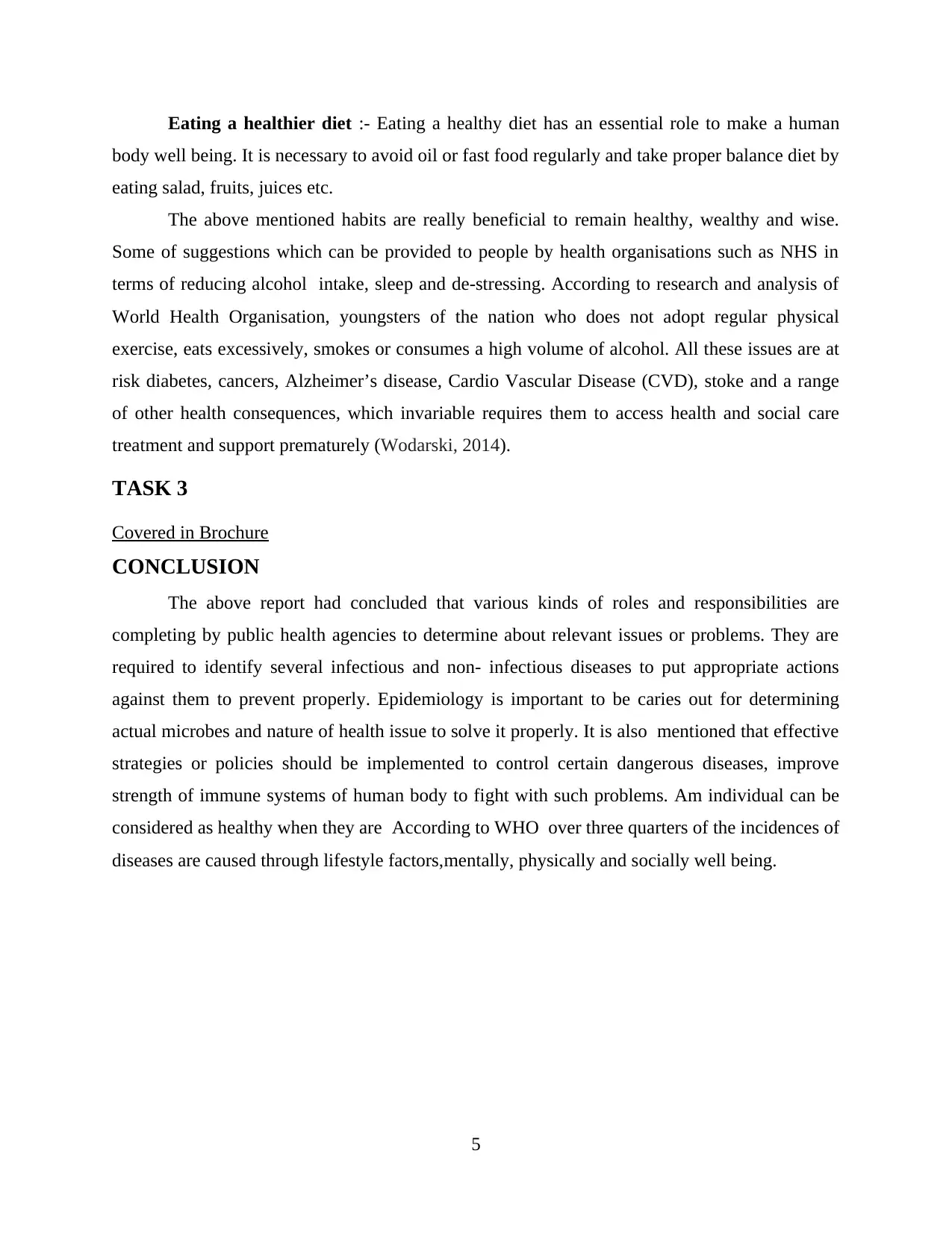
Eating a healthier diet :- Eating a healthy diet has an essential role to make a human
body well being. It is necessary to avoid oil or fast food regularly and take proper balance diet by
eating salad, fruits, juices etc.
The above mentioned habits are really beneficial to remain healthy, wealthy and wise.
Some of suggestions which can be provided to people by health organisations such as NHS in
terms of reducing alcohol intake, sleep and de-stressing. According to research and analysis of
World Health Organisation, youngsters of the nation who does not adopt regular physical
exercise, eats excessively, smokes or consumes a high volume of alcohol. All these issues are at
risk diabetes, cancers, Alzheimer’s disease, Cardio Vascular Disease (CVD), stoke and a range
of other health consequences, which invariable requires them to access health and social care
treatment and support prematurely (Wodarski, 2014).
TASK 3
Covered in Brochure
CONCLUSION
The above report had concluded that various kinds of roles and responsibilities are
completing by public health agencies to determine about relevant issues or problems. They are
required to identify several infectious and non- infectious diseases to put appropriate actions
against them to prevent properly. Epidemiology is important to be caries out for determining
actual microbes and nature of health issue to solve it properly. It is also mentioned that effective
strategies or policies should be implemented to control certain dangerous diseases, improve
strength of immune systems of human body to fight with such problems. Am individual can be
considered as healthy when they are According to WHO over three quarters of the incidences of
diseases are caused through lifestyle factors,mentally, physically and socially well being.
5
body well being. It is necessary to avoid oil or fast food regularly and take proper balance diet by
eating salad, fruits, juices etc.
The above mentioned habits are really beneficial to remain healthy, wealthy and wise.
Some of suggestions which can be provided to people by health organisations such as NHS in
terms of reducing alcohol intake, sleep and de-stressing. According to research and analysis of
World Health Organisation, youngsters of the nation who does not adopt regular physical
exercise, eats excessively, smokes or consumes a high volume of alcohol. All these issues are at
risk diabetes, cancers, Alzheimer’s disease, Cardio Vascular Disease (CVD), stoke and a range
of other health consequences, which invariable requires them to access health and social care
treatment and support prematurely (Wodarski, 2014).
TASK 3
Covered in Brochure
CONCLUSION
The above report had concluded that various kinds of roles and responsibilities are
completing by public health agencies to determine about relevant issues or problems. They are
required to identify several infectious and non- infectious diseases to put appropriate actions
against them to prevent properly. Epidemiology is important to be caries out for determining
actual microbes and nature of health issue to solve it properly. It is also mentioned that effective
strategies or policies should be implemented to control certain dangerous diseases, improve
strength of immune systems of human body to fight with such problems. Am individual can be
considered as healthy when they are According to WHO over three quarters of the incidences of
diseases are caused through lifestyle factors,mentally, physically and socially well being.
5
Paraphrase This Document
Need a fresh take? Get an instant paraphrase of this document with our AI Paraphraser
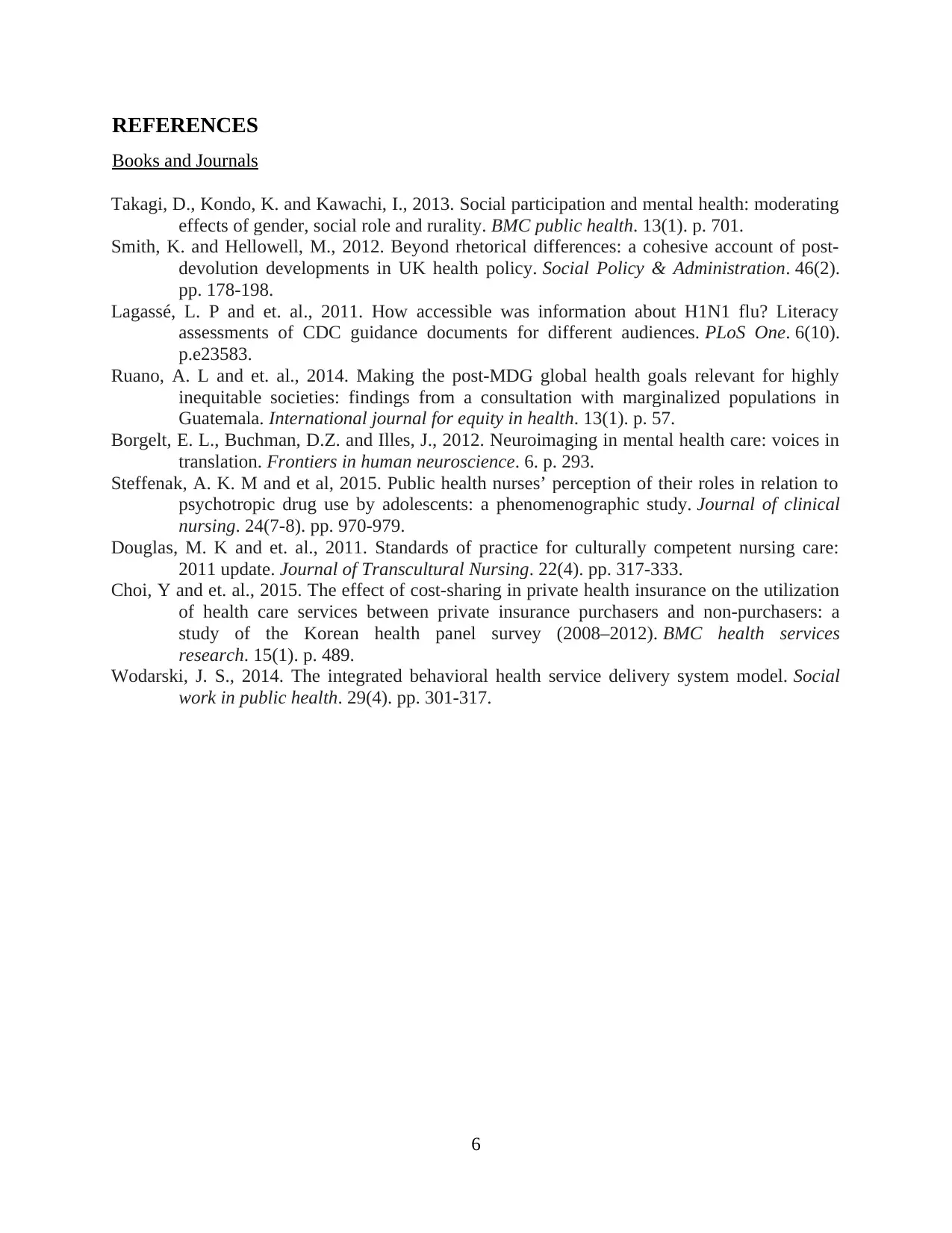
REFERENCES
Books and Journals
Takagi, D., Kondo, K. and Kawachi, I., 2013. Social participation and mental health: moderating
effects of gender, social role and rurality. BMC public health. 13(1). p. 701.
Smith, K. and Hellowell, M., 2012. Beyond rhetorical differences: a cohesive account of post‐
devolution developments in UK health policy. Social Policy & Administration. 46(2).
pp. 178-198.
Lagassé, L. P and et. al., 2011. How accessible was information about H1N1 flu? Literacy
assessments of CDC guidance documents for different audiences. PLoS One. 6(10).
p.e23583.
Ruano, A. L and et. al., 2014. Making the post-MDG global health goals relevant for highly
inequitable societies: findings from a consultation with marginalized populations in
Guatemala. International journal for equity in health. 13(1). p. 57.
Borgelt, E. L., Buchman, D.Z. and Illes, J., 2012. Neuroimaging in mental health care: voices in
translation. Frontiers in human neuroscience. 6. p. 293.
Steffenak, A. K. M and et al, 2015. Public health nurses’ perception of their roles in relation to
psychotropic drug use by adolescents: a phenomenographic study. Journal of clinical
nursing. 24(7-8). pp. 970-979.
Douglas, M. K and et. al., 2011. Standards of practice for culturally competent nursing care:
2011 update. Journal of Transcultural Nursing. 22(4). pp. 317-333.
Choi, Y and et. al., 2015. The effect of cost-sharing in private health insurance on the utilization
of health care services between private insurance purchasers and non-purchasers: a
study of the Korean health panel survey (2008–2012). BMC health services
research. 15(1). p. 489.
Wodarski, J. S., 2014. The integrated behavioral health service delivery system model. Social
work in public health. 29(4). pp. 301-317.
6
Books and Journals
Takagi, D., Kondo, K. and Kawachi, I., 2013. Social participation and mental health: moderating
effects of gender, social role and rurality. BMC public health. 13(1). p. 701.
Smith, K. and Hellowell, M., 2012. Beyond rhetorical differences: a cohesive account of post‐
devolution developments in UK health policy. Social Policy & Administration. 46(2).
pp. 178-198.
Lagassé, L. P and et. al., 2011. How accessible was information about H1N1 flu? Literacy
assessments of CDC guidance documents for different audiences. PLoS One. 6(10).
p.e23583.
Ruano, A. L and et. al., 2014. Making the post-MDG global health goals relevant for highly
inequitable societies: findings from a consultation with marginalized populations in
Guatemala. International journal for equity in health. 13(1). p. 57.
Borgelt, E. L., Buchman, D.Z. and Illes, J., 2012. Neuroimaging in mental health care: voices in
translation. Frontiers in human neuroscience. 6. p. 293.
Steffenak, A. K. M and et al, 2015. Public health nurses’ perception of their roles in relation to
psychotropic drug use by adolescents: a phenomenographic study. Journal of clinical
nursing. 24(7-8). pp. 970-979.
Douglas, M. K and et. al., 2011. Standards of practice for culturally competent nursing care:
2011 update. Journal of Transcultural Nursing. 22(4). pp. 317-333.
Choi, Y and et. al., 2015. The effect of cost-sharing in private health insurance on the utilization
of health care services between private insurance purchasers and non-purchasers: a
study of the Korean health panel survey (2008–2012). BMC health services
research. 15(1). p. 489.
Wodarski, J. S., 2014. The integrated behavioral health service delivery system model. Social
work in public health. 29(4). pp. 301-317.
6
1 out of 8
Related Documents
Your All-in-One AI-Powered Toolkit for Academic Success.
+13062052269
info@desklib.com
Available 24*7 on WhatsApp / Email
![[object Object]](/_next/static/media/star-bottom.7253800d.svg)
Unlock your academic potential
Copyright © 2020–2025 A2Z Services. All Rights Reserved. Developed and managed by ZUCOL.




